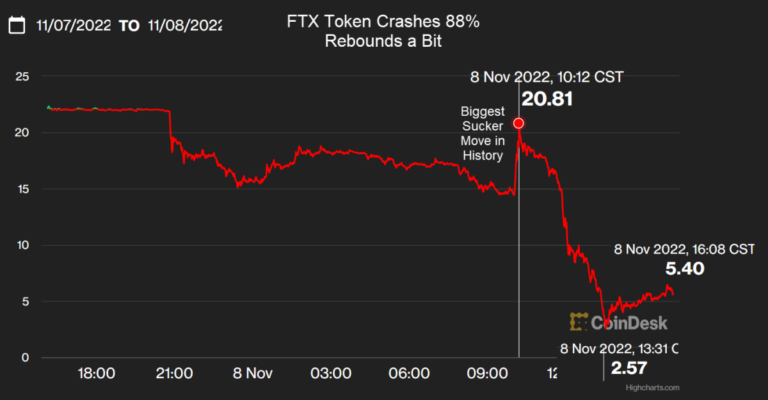The spectacular implosion of cryptocurrency exchange FTX, a so-called unicorn startup that was recently valued at $32 billion, is just the latest bit of bad news for investors in bitcoin, ethereum and other digital assets. But 2022 was already an awful year for crypto before the FTX-Binance soap opera.
Bitcoin prices are currently hovering around $16,500, down from a level of $20,000 just a week ago. Still, even at $20,000, that was a far cry from the price of just north of $46,000 that bitcoin was trading at on the last day of 2021.
It turns out that investors who were hoping that rising interest rates and higher levels of inflation would be good for so-called alternative assets like cryptos and gold have been in for a rude awakening this year.
They’ve gotten hit just like stocks and bonds, proving there really is no place to hide in a market where worries about rate hikes and recession reign supreme.
Gold prices have fallen about 6% this year, and the price of the yellow metal is not far from the lows it hit at the beginning of the Covid-19 pandemic in early 2020. Gold, like bitcoin, then surged in the latter part of 2020 as a sort of safe haven trade.
So can gold and crypto bounce back? The strength of the US dollar has hurt both precious metals and cryptos. Why buy gold or digital assets when the greenback is proving to be the king of currencies?
Some experts are hopeful that the worst could soon be over for bitcoin and other cryptocurrencies.
Bitcoin has historically had big swings up and down
This isn’t the first time that there has been a so-called crypto winter. Bitcoin prices have been notoriously volatile over the past few years, but they have still done better than many major stock market indexes.
Just look at bitcoin prices since the summer of 2020. They’re up more than 80%…even though it has been far from a smooth ride. The Nasdaq, by way of comparison, is only up about 1% from July 2020 levels.
“Bitcoin and ethereum went straight up and down but they have still gained a lot from mid-2020. Over that longer time horizon, digital assets are still outperforming tech stocks,” said Jeff Dorman, chief investment officer at Arca, a firm that specializes in crypto.
The crypto crash has also led to a massive plunge in the shares of publicly traded companies with ties to bitcoin, such as Coinbase, crypto mining firms Hive (HVBTF) and Riot (RIOT) and bitcoin bank Silvergate (SI).
Overreaction in the broader crypto sector?
Some analysts think that it’s a mistake though to punish the entire crypto industry because of the problems at FTX. The near-collapse of FTX, one of the largest cryptocurrency exchanges, has prompted questions of contagion.
“While we acknowledge that the FTX saga could weigh on the crypto space in the near term, we also believe the sell-off in [Silvergate] shares…reflected significant misunderstanding of the mechanics of the company’s platform,” said Mark Palmer, head of digital asset research at BTIG, in a report.
One venture capitalist who focuses on bitcoin and crypto assets agreed that FTX’s problems won’t derail the entire digital assets universe.
“Investors don’t appear to be concerned about the impact of FTX on bitcoin’s future,” said Alyse Killeen, founder and managing partner of venture firm Stillmark. To that end, her company recently invested in bitcoin infrastructure firm Hoseki, a company that is also backed by the parent company of Fidelity.
Killeen added that the drop in bitcoin prices that was occurring even before the FTX meltdown is a sign that cryptocurrencies are not yet a true hedge against inflation and a stronger dollar.
That may eventually change once bitcoin matures. But for now, crypto adoption is still in its nascent stages. So dollar strength is still a negative for bitcoin.
“Bitcoin is still young. It is still a new form of currency, payment and store of value,” she said.
Gold isn’t glittering yet either
The strength of the mighty dollar has been a headwind for gold, too, and it’s not yet clear if the greenback is going to weaken substantially anytime soon…even though October inflation figures showed a smaller than expected jump in consumer prices. That could lead the Fed to start slowing its pace of rate hikes.
“In this current environment, monetary policy remains the dominant force,” said Joe Cavatoni, chief market strategist for North America with the World Gold Council. “I’ll be looking out to see what happens to investment demand and the gold price once inflation settles at a steady rate.”
Cavatoni said that gold weakness this year is due primarily to a “more tactical response to persistent Fed rate hikes and the surging US dollar” from big institutional investors.
The dollar may have more room to run. That could be more bad news for gold.
“Cash has still been king,” said Bob Doll, chief investment officer at Crossmark Global Investments. “The dollar eventually has to weaken and that could get gold going again, but it’s hard to call tops and bottoms in currencies.”
“We’re not likely to get on board a dollar weakness. It’s not time to try and be a hero with gold,” he added.
CNN



























